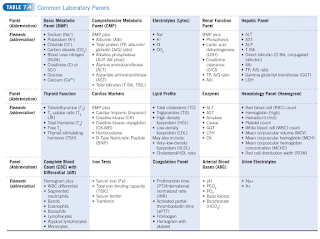Laboratory Data
Introduction
- Differentiate among possible diagnoses
- Confirm a diagnosis
- Assess current status
- Evaluate the response to therapy
when history and physical exam alone are insufficient
Related tests may be grouped together into a set called a profile or a panel, although small differences may exist between institutions panels.
Reference Range
The reference range is a statistically derived numeric range obtained by testing a sample of individuals assumed to be healthy. It is usually established as the mean ± 2 standard deviations.
- The reference population is assumed to have a Gaussian distribution with 68% of the values within one standard deviation (SD) above and below the mean (± 1 SD), 95% within ± 2 SD, and 99.7% within 3 SD.
- Reference ranges can vary between laboratories and facilities due to differences in analytic techniques, reagents and equipment.
- Reference ranges may also differ among populations and may change as new data are published.
The 'normal range' should be used with caution as it takes little account of an individual's age, sex, weight, height, muscle mass or disease state, many of which variables can influence test results.
NOTE: Abnormal values are not always clinically significant, and in some diseases or conditions, values within the reference range can be considered abnormal.
Interpretation Key Points
Laboratory results must be interpreted in context of the patient (i.e. clinical condition) and the limitations of the laboratory test.
- The presence or absence of signs and symptoms associated with the medical problem outweighs an isolated laboratory report.
Baseline results, rate of change and patterns should be considered when interpreting laboratory results.
- A disturbance of one parameter often cannot be considered in isolation without looking at the pattern of other tests within the group.
- Not all laboratory values above the upper limit of normal (ULN) require intervention. Some elevations may be transient and resolve with continued drug administration.
- For instance, the severity of infection is often reflected by parameters such as body temperature, white cell count, C-reactive protein and procalcitonin (indicative of bacterial infection).
- Conversely, renal function can be assessed through key parameters including creatinine clearance, albuminuria, urea and urine output.
- A series of values rather than a simple test value may be required in order to ensure clinical relevance and to eliminate erroneous values caused.
If laboratory error is suspected, the test should be repeated.
- Repeat testing of suspected spurious laboratory values increases the cost of patient care but may be necessary to rule out an actual abnormality.
- Laboratory error is an uncommon occurrence; however, it can happen.
- Potential causes of laboratory error include technical error, improper calculation, inadequate specimen, incorrect sampling timing, improper sample preservation, food substances affecting specimen, or medication interference with lab tests.
NOTE: May refer Critical Care Pharmacy Handbook for management of abnormalities in plasma sodium, potassium, calcium, magnesium and phosphate.
Summary
- Sensitivity refers to a test's ability to correctly identify individuals with the disease (the true positive rate).
- Highly sensitive tests are preferred when the consequences of missing a diagnosis are serious.
- Less sensitive tests may be acceptable if a false negative has less significant consequences, or if they are used in conjunction with other tests.
- Specificity, on the other hand, refers to the percentage of correctly identified negative results in individuals without the disease (the true negative rate).
- For example, a test with 95% specificity for a particular disease means that 5% of people without the disease will receive a positive test result.
- Tests with high specificity are best for confirming a diagnosis, as they are rarely positive when the disease is absent.
NOTE: Sensitivity can also refer to the range over which a quantitative assay can accurately measure the analyte. In this context, a sensitive test can measure low levels of the substance, whereas an insensitive test cannot accurately measure low levels.



Great post! I really appreciate how clearly you explained the importance of timely medical checkups. From my own experience, getting a laboratory test at the right time made a huge difference in catching a health issue early. It’s so important that more people understand how these tests can help with prevention and early diagnosis. Thanks for raising awareness!
ReplyDelete